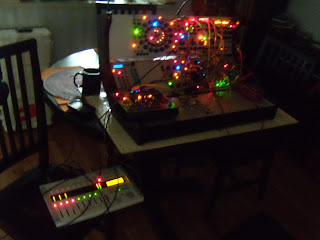One of the great things about being an electronic musician is the constantly evolving community on-line. There are forums, mailing lists, blogs, and sites which offer information and support on even the most obscure instrument, software, operating system, or vintage relic.
Another benefit of this is it is easier to find other like-minded individuals and create and share music and ideas. Those of us older types remember the days of "tape trading" when the only method of having a friend in another state or country hear your music was to put it on a cassette and put in in a mailbox. Like, with postage and such kids. Gasp!
Some great music came out of those days. I personally participated in a Devo, AC/DC, and two looping, and numerous "Electronic Music" compilation tapes and CDs. Perhaps in a more nostalgic post I'll muse on the joys and fun of those days but for today, the end of 2011, I'll take the leap forward and present you with an end-of-year present: SIGNS: A COMPILATION OF WIGGLERS’ GRAPHICAL NOTATIONS FOR THE BUCHLA SYNTHESIZER.
I'll let the curator of this fine release, Giorgio Sancristoforo, describe his efforts and the final CD as he does it best:
"Some months ago I’ve asked to the fellow Buchla musicians of the MuffWigglers website to participate to a collective experiment on music notation for the Buchla synthesizer. In the world of modular synthesizers music we often see free improvisations, sketches, etudes, but very rarely “composed” music with notation.
This experiment was an attempt to involve nowadays modular musicians in the field of composition by means of graphical notation.
The result is finally here. Signs is not only an amazing collection of mind blowing music, it is also the proof that notation in electronic music is alive and kicking and indeed deserve further explorations. I want to thank with all my heart all the contributors of this amazing work. I hope you will all enjoy it."
This experiment was an attempt to involve nowadays modular musicians in the field of composition by means of graphical notation.
The result is finally here. Signs is not only an amazing collection of mind blowing music, it is also the proof that notation in electronic music is alive and kicking and indeed deserve further explorations. I want to thank with all my heart all the contributors of this amazing work. I hope you will all enjoy it."
The download "CD" release includes a beautiful 22 page full color booklet with essays, bios, and descriptions of each of the pieces and artists. It is in high quality 320 KPS MP3 format and FREE!!!
You can download SIGNS as well as other fantastic cutting edge electronic music from the Gleetchplug Website here: http://www.gleetchplug.com/Gleetchplug/Releases.html
I'm proud to have a track on this great compilation. It was both challenging and fun. For full details download the release and check out the booklet!
Here is the full TRACKLIST:
1)Olga Kokcharova & Gianluca Ruggeri : Eidetic Landscape
2)Todd Barton : Altair II
3)Niklas Winde aka 7th DanSound : Men för helvete Älskling!
4)Cyril Baud aka Ernest Saint Laurent : Incursions 3
5)Didier Debril : Sequences
6)Giorgio Sancristoforo : Andante Molto Vago
7)David Talento : That Which Was Then Becoming
8)Lyonel Bauchet : Kinesthézic
9)Schleusolz : Waltzing at the shipyard
1)Olga Kokcharova & Gianluca Ruggeri : Eidetic Landscape
2)Todd Barton : Altair II
3)Niklas Winde aka 7th DanSound : Men för helvete Älskling!
4)Cyril Baud aka Ernest Saint Laurent : Incursions 3
5)Didier Debril : Sequences
6)Giorgio Sancristoforo : Andante Molto Vago
7)David Talento : That Which Was Then Becoming
8)Lyonel Bauchet : Kinesthézic
9)Schleusolz : Waltzing at the shipyard






























